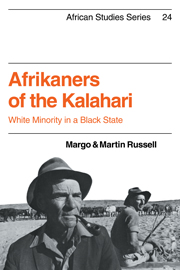Book contents
- Frontmatter
- Contents
- List of illustrations
- Acknowledgements
- A note on terminology
- 1 Southern Africa
- 1 The mundane Kalahari: an introduction
- 2 Boers, trekboers and bywoners: 1898–1930
- 3 Into the cash economy: 1930–72
- 4 Ghanzi Afrikaners 1973: a domestic description
- 5 Preserving boundaries: similarities, ambiguities and avoidances
- 6 Boers and Bushmen: dependence, interdependence and Independence
- 7 Sharing religion: attitudes to the conversion of the Bushmen to Christianity
- 8 Boers, bureaucrats and blacks
- 9 Prospect: whites in a black state
- Notes
- Bibliography
- Index
8 - Boers, bureaucrats and blacks
Published online by Cambridge University Press: 04 August 2010
- Frontmatter
- Contents
- List of illustrations
- Acknowledgements
- A note on terminology
- 1 Southern Africa
- 1 The mundane Kalahari: an introduction
- 2 Boers, trekboers and bywoners: 1898–1930
- 3 Into the cash economy: 1930–72
- 4 Ghanzi Afrikaners 1973: a domestic description
- 5 Preserving boundaries: similarities, ambiguities and avoidances
- 6 Boers and Bushmen: dependence, interdependence and Independence
- 7 Sharing religion: attitudes to the conversion of the Bushmen to Christianity
- 8 Boers, bureaucrats and blacks
- 9 Prospect: whites in a black state
- Notes
- Bibliography
- Index
Summary
Afrikaners provide a convenient object upon which tension and hostility can be projected, not only in South Africa, where they may collectively constitute a proper source of grievance, but across the continent and beyond. Stories of the same tenor as the Scotsman, the Irishman and the Jew indicate the unease which Afrikaners generate. The Afrikaner stereotype is summed up in the conundrum circulating amongst English civil servants in Botswana in 1973: ‘Why is an Afrikaner like rope?’ ‘Because he is thick, twisted and hairy.’
Such anecdotes possess some of the power of myth to propagate and keep intact a world view in which Afrikaners are ignorant, brutish and stupid. Their strong sense of ethnic identity is seen as an integral aspect of this syndrome of backwardness. While the social sciences have pointed to the flexibility of man to changing circumstances, there remains an obstinate popular tendency to see Afrikaners as exceptional to this finding, their behaviour as fixed and immutable. The very fact that Afrikaners have tended to share a common environment has lent credibility to the idea that they are all alike, not least in the matter of racialism.
British attitudes towards Afrikaners in the nineteenth century were percolated through the colonial experience, in which they were found to be awkward, cunning, hostile and evasive.
- Type
- Chapter
- Information
- Afrikaners of the KalahariWhite Minority in a Black State, pp. 118 - 134Publisher: Cambridge University PressPrint publication year: 1979



